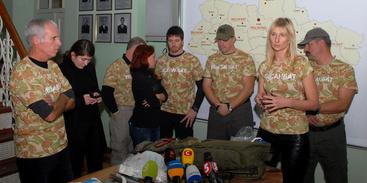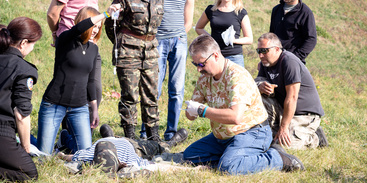Medsanbat announces registration for the new course for combat medics


All classes conducted within the frame of Tactical Combat Casualty Care and Advanced Trauma Life Support will be divided into five modules.
Evacuation – management, transport, packaging of major trauma, air transport NATO 9 Line, chemical and physical restraints, helicopter safety/landing, Talon stretcher, securing IV lines and other equipment, casualty card, hypothermia, C-collar for airway control, C-spine, triage, cessation of CPR in an austere environment.
Tourniquets – treatment, management, use, post tourniquet complications, nerve injury/muscle injury, compartment syndrome, crush injury, reperfusion, limb cooling, drug therapy, tranexamic acid (TXA).
Bandages and splinting – advanced splinting, SAM, Kendrick traction, suturing, fasciotomy, escharotomy, burns, pain management, wound care, post-traumatic pulmonary embolism, deep vein thrombosis, disseminated intravascular coagulation, rhabdomyolysis.
Circulation – IV management, piggy back lines, IO - intraosseous infusion and FAST1 device, saline lock, drug therapy, pill pack, prophylactic antibiotic therapy, tetanus.
Airway management – pleural decompression, advanced airway, ET, I-Gel, nasal ET basic airway, NPA, OPA, BVM, “tracking”, surgical airway, respiratory management, oxygen management, suction, 18 French NG, Vitalograph emergency suction device, Yankauer chest tube, pulseoximetry.
For the hands-on practice of medical procedures biological material was used – pigs heads, ribs, feet, parts of respiratory tract.
History of the project
First training took place Oct 9 through 13 in Kyiv, on the territory of the Main Miltiary Clinical Hospital in the conditions imitating real combat action. More than 200 doctors took part in the training, they are either preparing for deployment to units of MoD of Ukraine or are already servicing in the ATO.
In the first month of Medsanbat training hundreds of combat medics took the course in Kyiv, Mariupol, Sloviansk, Dnipropetrovsk, Kuibyshevo, Khmelnytskyi, Zhytomyr and Lviv. Trainings were organized according to the NATO standards and directed by American instructors each of which has an impressive experience of medical practice in active special forces units. In November the new stage of the course began, when Ukrainian instructors, who took the full training course, will be teaching their counterparts the modern principles of medical care before the casualty gets into a MFH or a static medical facility.
Trainings take place in hospitals in static auditoriums as well as in mobile field hospitals, on training grounds where the units fighting in the ATO are deployed.
Combat medics who were deployed or returning to the ATO after completion of the course following the decision of instructors were issued 50 medic begs, fully equipped with drugs and medical tools according to the NATO standards to provide first aid in combat situations. Another 50 bags are coming into Ukraine now.
The project is done in cooperation with the Military Medical Department of the MoD of Ukraine with the support of the International Association for Support of Ukraine Charity Fund and in partnership with the Ukrainian World Congress within the Patriot Defence project (www.patriotdefence.org), that is already doing active training for soldiers providing IFAKs and initiated the project of combat medics support.
Help for Combat Medics
Mid August 2014, Elena Pinchuk ANTIAIDS Foundation gave to the Main Military Clinical Hospital in Kyiv and to Kharkiv Military Hospital modern enzyme immunoassay analyzers that will enable military medics to test high volumes of blood that is needed to provide emergency care for the warfighters injured in action. It means that they will be protected from the possible risk of being infected with hepatitis and HIV infection in the process of donor blood transfusion, the need of which increases every day.
New equipment with total cost of 72.000 $ makes it possible to do up to 200 blood tests per hour on each of the analyzers for more than 30 infections including hepatitis and HIV infection, identify tumor markers and allergens, recognize autoimmune systemic diseases. The specific feature of this equipment is that the tests are conducted in automatic mode. This reduces the probability of mistakes significantly, reduces the time of testing and enables to process a larger number of blood samples. Medics can use reagents and test systems of any manufacturers. Besides of that, this equipment can be widely used for providing care in peacetime.
Situation with medical care in the ATO zone
According to the assessment of independent experts the system of medical care on the battlefield in the ATO does not meet the key requirements used in NATO army and in Israel. Mobile and field hospitals do not meet international standards, most of their equipment is outdated and does not meet basic requirements, especially in the situation when the load on one mobile hospital is up to 300 surgical operations a month. Evacuation of the injured from the battlefield is associated with great risk, evacuation to hospitals is complicated and medical aid is sometimes delayed up to 12 hours instead the necessary 60 minutes. Providing soldiers with individual aid kits, trained doctors with necessary medicines and medical equipment and the existence of a system of evacuation and transport of the wounded to mobile and static hospitals we can reduce mortality among the military contingent significantly and save health to thousands of defenders of Ukraine.
Medsanbat Facebook page – www.facebook.com/medsanbat, project website www.medsanbat.info.
For detailed information please contact Pavel Piminov, communications director of Elena Pinchuk ANTIAIDS Foundation: +380 44 490 4805, [email protected].









